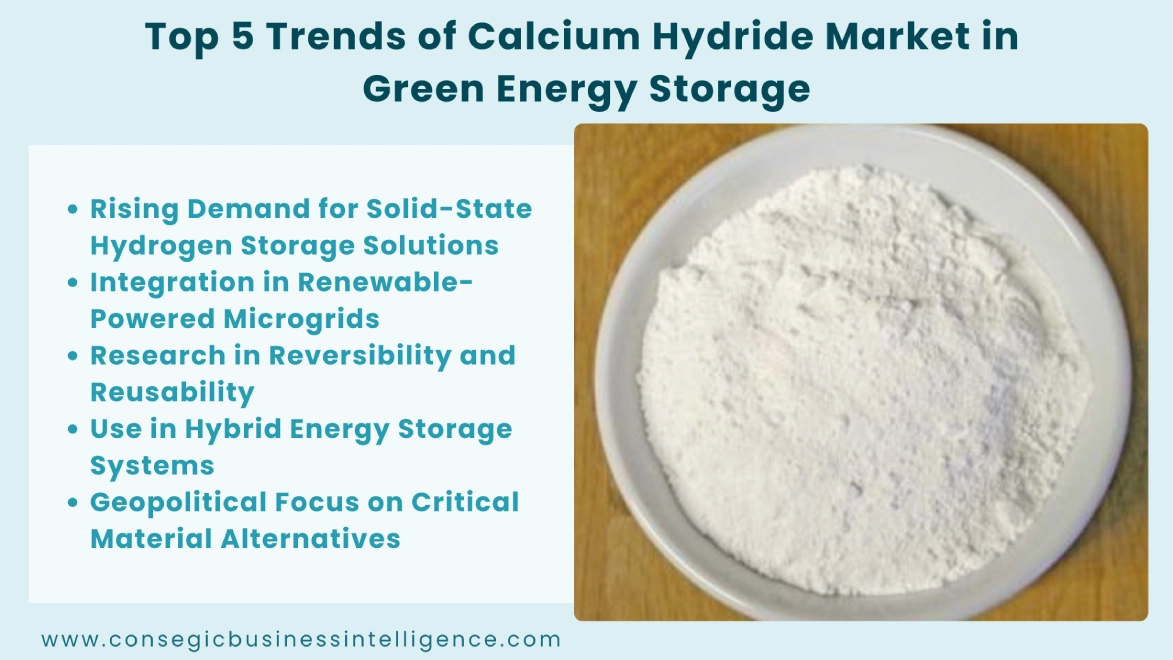Market Guide - Top 5 Trends of Calcium Hydride Market in Green Energy Storage
Category : Materials And Chemicals | Published Date : May 2025 | Type : Press Release
A grayish-white inorganic compound, calcium hydride (CaH2), reacts vigorously with water, enabling its extensive application as a drying agent. Its attributes of high reactivity, thermal stability, and effective desiccation drive its adoption in the chemical and metallurgical industries. Furthermore, the calcium hydride market size is estimated to reach over USD 515.53 Million by 2032 from a value of USD 368.52 Million in 2024 and is projected to grow by USD 377.90 Million in 2025, growing at a CAGR of 4.5% from 2025 to 2032. This blog explores the five most impactful calcium hydride trends under green energy storage, offering insights into solid-state hydrogen storage solutions, renewable-powered microgrids, research in reversibility and reusability, hybrid energy storage systems, and growing geopolitical focus on critical material alternatives.

1. Rising Demand for Solid-State Hydrogen Storage Solutions
Calcium hydride is increasingly used as a safer, solid-state alternative for hydrogen storage as compared to compressed gas or cryogenic hydrogen. This is because it allows the controlled release of hydrogen temperatures, making it ideal for off-grid renewable energy systems and mobile storage units. The operating principle of calcium hydride as a storage solution lies in the reversible interaction between hydrogen and metals and alloys that produce hydrides. Moreover, it eliminates the issues faced with compressed hydrogen storage, such as material durability, tank safety, and overall weight. The solid-state storage technology is expected to be utilized in industries requiring hydrogen, like petroleum refineries, ammonia and other chemical production, automobiles, transportation, and stationary power storage. Additionally, their adoption is boosted by government-funded hydrogen economy initiatives in Asia and Europe.
2. Integration in Renewable-Powered Microgrids
The potential integration of calcium hydride in renewable energy microgrids to store surplus energy from solar and wind offers market opportunities. The system enables long-term electricity storage with nearly no loss of stored hydrogen. Furthermore, they have adaptable sizing as power and energy are independent of each other in hydrogen systems. This has resulted in utility companies and microgrid developers investing in pilot-scale demonstrations in order to enhance grid resilience and reduce lithium-ion battery dependency, further expanding the market.
3. Research in Reversibility and Reusability
Another trend driving the market includes the constant research to improve the reversibility and reusability of the hydrogenation/dehydrogenation cycles of CaH₂. Since it often faces issues in reabsorbing hydrogen efficiently, researchers are globally investigating methods to enhance this process and expand their reusability. This involves doping calcium hydride with catalysts, nanostructuring, and creating CaH₂-based composites to elevate kinetics and thermodynamic properties. This research holds potential for developing rechargeable hydrogen storage modules for repeated use in renewable grids. Furthermore, these advancements are encouraged by clean energy grants from the government focused on circular energy solutions.
4. Use in Hybrid Energy Storage Systems
Calcium hydride is finding application in hybrid energy storage systems such as thermal storage and fuel cell technologies due to its high thermochemical energy storage densities through reversible hydrogenation. Moreover, the addition of aluminium lowers the operating temperature below 700°C, enabling safer operation and production. Additionally, calcium hydride not only aids heat generation but also assists in the storage of chemical hydrogen in a safe manner. Thus, its application in hybrid systems has improved energy efficiency and extended its use. As a result, it has become a popular choice for industries with both power and heat needs, such as food processing or chemical plants.
5. Geopolitical Focus on Critical Material Alternatives
Lastly, the utilization of calcium hydride is bolstered by its abundance and relative geopolitical stability, as compared to lithium and cobalt. Calcium is more easily available and less subject to mining restrictions, making it a suitable alternative. Furthermore, this trend is supported by governments encouraging the domestic production and refining of calcium hydride to reduce foreign dependency and achieve clean energy independence. Moreover, the shift is also propelled by the growing strategic interest in reducing the reliance on rare earth elements.
In conclusion, the calcium hydride market is developing rapidly with key trends including solid-state hydrogen storage solutions, renewable-powered microgrid, research in reversibility and reusability, hybrid energy storage systems, and a growing geopolitical focus on critical material alternatives. The above factors are further driving the market growth.












